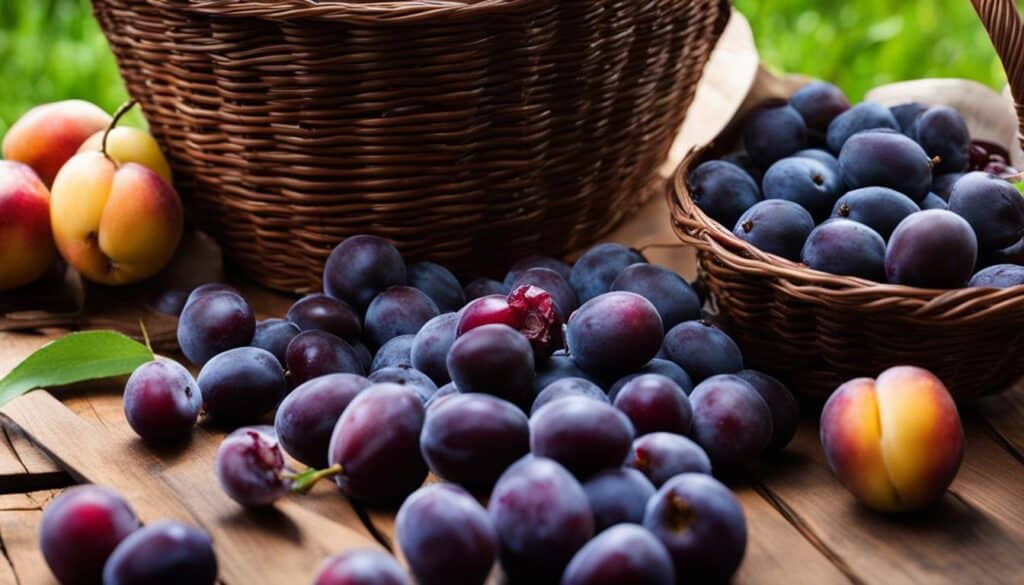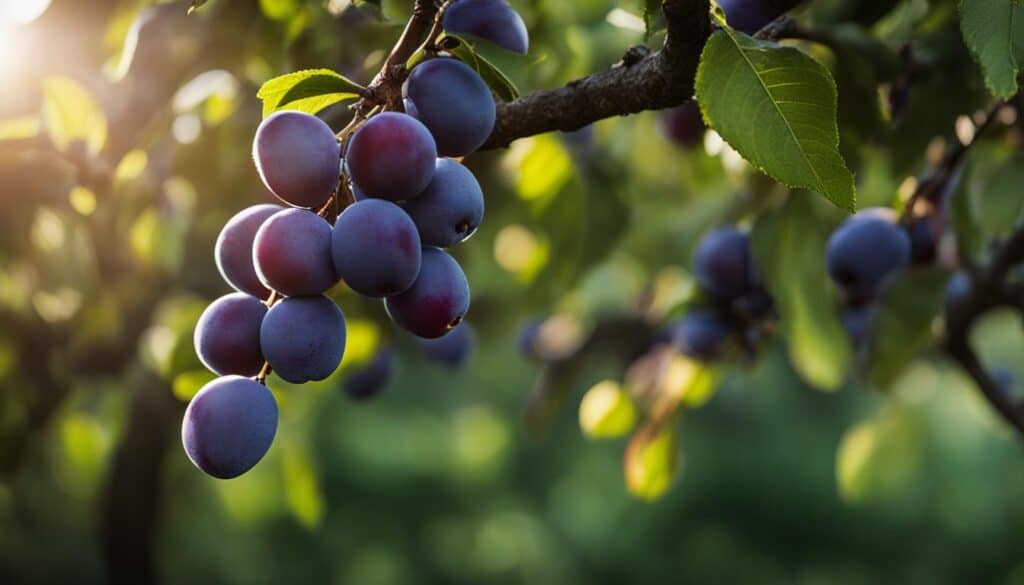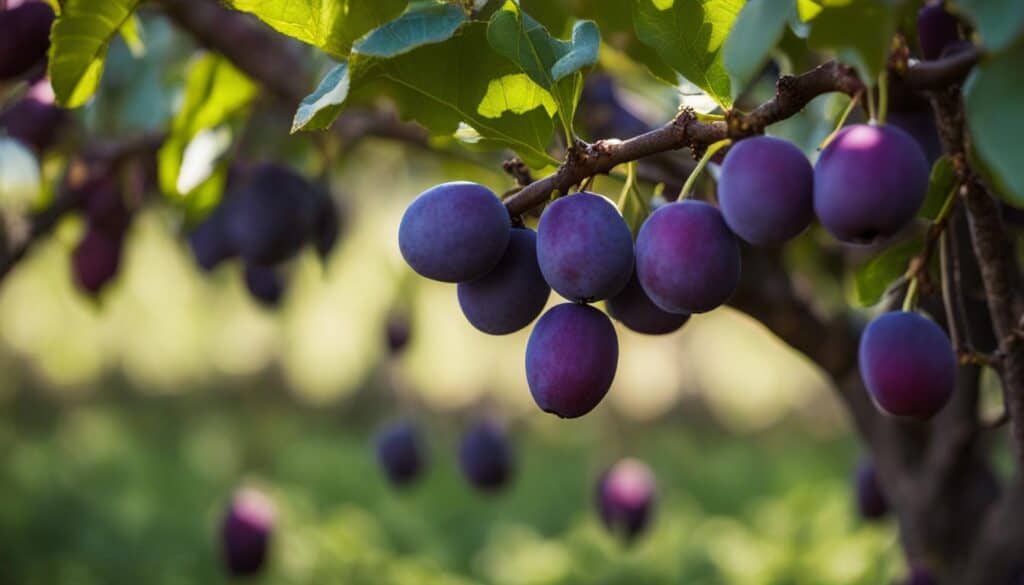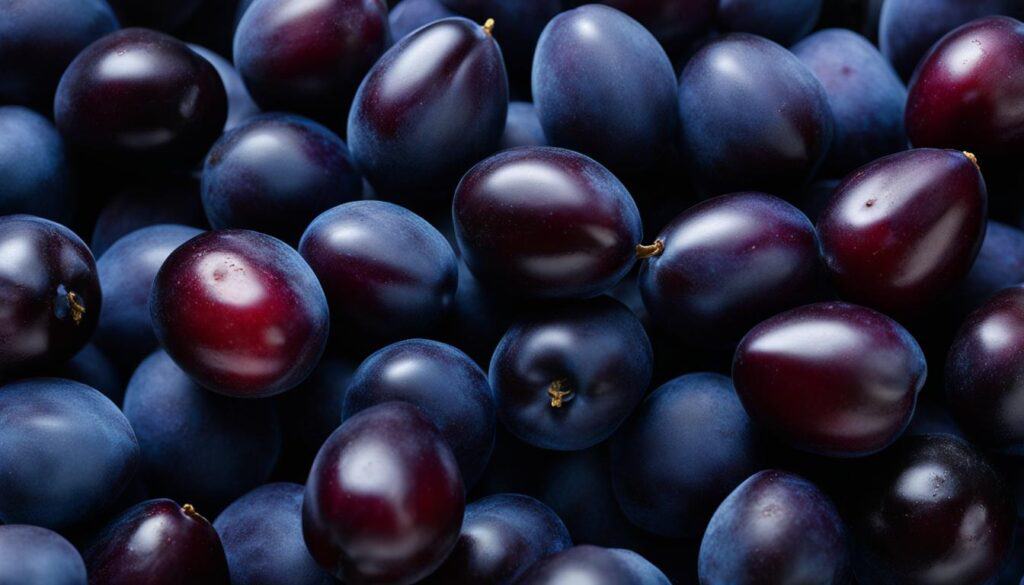Hello, fellow food enthusiasts! Today, I want to talk to you about a hidden gem in the world of fruits – the tantalizing damson plum. Join me on a journey to explore the unique characteristics, health benefits, and culinary possibilities of this lesser-known plum variety.
Damson plums are a delightful fruit that offers a burst of flavor like no other. With their soft yellow flesh and purple or blue skin, they are a sight to behold. What makes damson plums truly special is their versatility – they can be sweet or tart, depending on the variety.
These plums have a fascinating history that dates back to ancient times. Cultivation evidence suggests that damson plums have been enjoyed for centuries. In fact, they were first cultivated in the region surrounding Damascus, inspiring their name.
Aside from their delicious taste, damson plums also come packed with health benefits. They are a great source of vitamin C and dietary fiber, making them a healthy addition to your diet.
Now, you might be wondering how to use damson plums in your kitchen. From jams and jellies to pies and sauces, the possibilities are endless. Damson plums are in season from late summer to early fall, so it’s the perfect time to incorporate them into your recipes.
If you’re excited to try damson plums, you might be wondering where to find them. While they may not be easily available at all stores, you can look for them at select local stores or explore online options to get your hands on these flavor-packed plums.
Key Takeaways:
- Damson plums are a lesser-known variety with a rich flavor and unique characteristics.
- They offer health benefits, including being a good source of vitamin C and dietary fiber.
- Damson plums can be used in a variety of recipes, from jams and jellies to pies and sauces.
- They are in season in late summer to early fall.
- You can find damson plums at select stores or purchase them online.
What is a Damson Plum?
Damson plums are a unique variety of plum that come in various colors, tastes, and shapes. These small fruits have a soft yellow flesh and a rich indigo blue, red, or purple skin. The Shropshire damson variety has a mildly acidic taste, while the Merryweather damson has a sweeter flavor. Damson plums are typically oval-shaped with a slightly pointy end.
These plums belong to the same family as other plum varieties and are harvested in late summer to early fall. While some damson plums can be eaten fresh, they are generally known for their tartness and are more commonly used in cooking and baking.
What is a Damson Plum?
“Damson plums are a unique variety of plum that come in various colors, tastes, and shapes. The Shropshire damson has a mildly acidic taste, while the Merryweather damson has a sweeter flavor. These plums have a soft yellow flesh and a rich indigo blue, red, or purple skin. They are typically oval-shaped with a slightly pointy end.”
Damson plums are a versatile fruit that can add a burst of flavor to a variety of dishes. From jams and jellies to pies and sauces, these plums offer a rich and unique taste. Their color, taste, and shape make them stand out among other plum varieties.
Table: Damson Plum Varieties
| Variety | Color | Taste | Shape |
|---|---|---|---|
| Shropshire Damson | Indigo blue | Mildly acidic | Oval with a slightly pointy end |
| Merryweather Damson | Red or purple | Sweeter flavor | Oval with a slightly pointy end |
(Source: The Damson Association)
The History of Damson Plums
Let’s take a journey back in time to explore the fascinating history of damson plums. These unique fruits have been cultivated for centuries, with evidence of their cultivation dating back to ancient times. The name “Damson” originates from the region surrounding Damascus, where these plums were originally grown. Their cultivation spread across Europe, and it is believed that the Romans introduced them to England.
During ancient times, damson plums played a significant role beyond their culinary uses. The skins of these plums were valued for their ability to produce purple dye, which was used in various applications. Archaeological digs in England have uncovered damson plums dating back to the Roman era, showcasing their enduring presence throughout history.
The exact timeline of the introduction of damson plums to North America remains uncertain, but it is likely that they were brought by early settlers. Today, damson plums can be found in select stores or purchased online, allowing us to continue enjoying the rich history and unique flavors of these remarkable fruits.
The Cultivation of Damson Plums
The cultivation of damson plums has evolved over time, but their unique characteristics and flavors remain unchanged. These plums thrive in temperate climates and are harvested in late summer to early fall. Damson plum trees are known for their moderate growth rate and ability to tolerate different soil types. They prefer full sun and well-draining soil, showcasing their adaptability.
Introduction to North America
The introduction of damson plums to North America marked the beginning of a new chapter in their history. While the exact details remain unclear, it is plausible that early settlers brought the seeds or young saplings with them. Since then, damson plums have become a cherished fruit in various regions across the continent, captivating our taste buds with their rich flavors and versatility in recipes.
Health Benefits of Damson Plums

Damson plums offer several health benefits that make them a nutritious addition to your diet. They are rich in vitamin C, which boosts your immune system and helps protect your cells from damage. The high dietary fiber content in damson plums promotes healthy digestion and can help regulate your cholesterol levels. These plums also contain essential minerals like phosphorus, copper, manganese, magnesium, and potassium, which are vital for various bodily functions.
A unique benefit of damson plums is their potential to combat fatigue. The minerals present in these plums, such as manganese and magnesium, play a crucial role in energy production and can help alleviate tiredness. Additionally, damson plums contain phytonutrients that have been studied for their potential anti-cancer properties. Research suggests that these phytonutrients may help reduce or inhibit the growth of breast cancer cells.
Health Benefits of Damson Plums
Another advantage of including damson plums in your diet is their low calorie content. They are a great choice for those looking to maintain or lose weight while still enjoying the sweetness and flavor of fruits. With only a little over 30 calories per 100 grams, damson plums are a guilt-free snack or ingredient in various recipes.
In summary, damson plums provide numerous health benefits. They are packed with vitamin C, dietary fiber, and essential minerals. These plums can help boost your immune system, support digestive health, combat fatigue, and potentially inhibit breast cancer cell growth. With their low calorie content, they are a healthy choice for those watching their weight. Incorporating damson plums into your diet can enhance both the flavor and nutritional value of your meals.
Fun Facts about Damson Plums
Did you know that damson plums are not only delicious but also have some interesting uses? Here are a few fun facts about damson plums:
- Damson plums can be used to make gin, similar to the process of making sloe gin from sloe berries. The tartness of the plums adds a unique flavor to the spirit.
- Another spirit made with damson plums is Slivovitz, a distilled drink popular in Slavic countries. This strong liquor is made by fermenting and distilling ripe damson plums.
- Damson plums are also used to make fruit liqueurs, vodka, and wine. The intense flavor of the plums lends itself well to creating flavorful and aromatic beverages.
But the uses of damson plums don’t stop there! Due to their tart and acidic nature, people have found creative ways to incorporate damson plums into various dishes. They can be used to make sauces and stuffings for roast duck and other game meats, adding a burst of flavor to the dish.
“Damson plums are a versatile fruit that can be used in many different ways. From making spirits like gin and Slivovitz to creating delicious liqueurs and wines, damson plums offer a unique taste and aroma. They are not just for eating fresh or making jams and jellies—they can elevate your culinary creations to the next level!”
The Uses of Damson Plums
Here are some of the popular uses for damson plums:
| Uses | Description |
|---|---|
| Jams and Jellies | Damson plums are commonly used to make delicious jams and jellies. The tartness of the plums adds a unique flavor to the spreads. |
| Pies and Tarts | These plums are perfect for making pies and tarts. When cooked, their flavor intensifies, creating a rich and sweet filling. |
| Sauces and Compotes | Damson plums can be cooked down into a sauce or compote, which can be used as a topping for pancakes, waffles, or yogurt. |
| Liqueurs and Spirits | The intense flavor of damson plums makes them ideal for infusing into liqueurs or spirits, adding a unique twist to your cocktails. |
As you can see, damson plums are not just your average plum. They offer a range of uses, from making spirits to creating delicious jams and pies. So the next time you come across damson plums, get creative in the kitchen and explore their full potential!
How to Use Damson Plums
Damson plums, with their unique flavor and tartness, are a versatile fruit that can be used in various ways. While they are not typically eaten fresh, they are commonly used to make delicious homemade jelly or jam. The natural pectin in damson plums makes them perfect for creating a thick and flavorful spread. Whether you enjoy it on toast or use it as a filling for pastries, damson plum jam is sure to delight your taste buds.
In addition to jelly and jam, damson plums can also be cooked to make pies, compotes, and chutneys. Their intense flavor adds a tangy and sweet element to these dishes. You can also use damson plums to make a flavorful sauce that pairs well with meats like duck or lamb. The plums’ rich flavor is enhanced when combined with spices like cinnamon or ginger, creating a delicious and aromatic sauce.
If you’re feeling adventurous, you can even try pickling or canning damson plums. Pickled damsons make a great addition to charcuterie boards or salads, providing a tangy and slightly sweet flavor. Canned damson plums can be preserved and enjoyed throughout the year, allowing you to savor their unique taste even when they are out of season. The possibilities are endless when it comes to using damson plums in your culinary endeavors.
Table: Ways to Use Damson Plums
| Jelly or Jam | Pie | Compote |
|---|---|---|
| Create a thick and flavorful spread | Make a delicious dessert with a tangy twist | Add a sweet and tangy element to your breakfast or dessert |
| Chutney | Sauce | Spread |
| Add a tangy and flavorful condiment to your meals | Create a rich and aromatic sauce for meats | Pair with cream cheese or use as a sweet topping for crackers |
What is a Damson Plum Tree?

The damson plum tree is a small fruit tree known for its delicious and unique damson plums. These trees come in different varieties and sizes, making them suitable for gardens of all sizes. The standard variety can reach up to twenty feet in height and width, providing ample fruit production. On the other hand, the dwarf variety is more compact, reaching around ten feet in width and height, making it perfect for smaller spaces.
When it comes to growth rate, damson plum trees have a moderate pace, usually growing about one to two feet each year. This steady growth allows you to carefully nurture and manage your tree over time. Damson plum trees thrive in full sun, so be sure to plant them in a sunny spot in your garden. They also prefer well-draining soil but can tolerate different soil types, providing flexibility in choosing the perfect location.
One notable characteristic of damson plum trees is their cold-hardiness. These trees can withstand a range of growing zones, making them suitable for various climates. Whether you live in a colder region or a milder one, you can enjoy the beauty and bounty of a damson plum tree in your garden.
Varieties and Attributes of Damson Plum Trees
| Variety | Size | Growth Rate | Sun | Soil | Cold-Hardy |
|---|---|---|---|---|---|
| Standard | Up to 20 feet tall and wide | Moderate | Full sun | Well-draining, but tolerant of different soil types | Cold-hardy |
| Dwarf | Around 10 feet tall and wide | Moderate | Full sun | Well-draining, but tolerant of different soil types | Cold-hardy |
“Damson plum trees are a wonderful addition to any garden. With their manageable size, moderate growth rate, and cold-hardiness, they offer both beauty and bounty. Planting a damson plum tree in your garden will not only provide you with delicious fruit but also add a touch of natural elegance to your outdoor space.” – Gardening Expert
How to Grow Damson Plum Trees

When it comes to growing your own damson plum trees, there are a few key steps to keep in mind. Start by selecting a suitable location for planting, ensuring the area receives full sun. Damson plum trees thrive in well-drained soil but are tolerant of different soil types. Prepare the soil by digging a hole that is wide and deep enough to accommodate the root system of the tree.
When planting damson plum trees, it’s important to consider pollination. While damsons are self-fertile, planting multiple trees can increase the chances of a bountiful harvest. Space the trees about 15 to 20 feet apart to give them enough room to grow and spread their branches.
Maintenance for damson plum trees is relatively low. They have a moderate growth rate, typically growing one to two feet each year. Pruning is minimal and involves the removal of old dead branches to promote new growth. Damson plum trees are often shipped as bare root trees, so proper soil filling is crucial for their healthy growth.
| Planting | Pollination | Maintenance | Pruning | Space | Bare Root Trees |
|---|---|---|---|---|---|
| Choose a sunny location with well-drained soil. | Plant multiple trees for better pollination. | Low maintenance with minimal pruning. | Remove old dead branches for new growth. | Space trees 15 to 20 feet apart. | Proper soil filling for healthy growth. |
Tip for Success: Watering and Fertilizing
Watering is crucial during the first few years after planting to establish a strong root system. Keep the soil consistently moist but not waterlogged. Once the tree is established, regular rainfall should be sufficient, although additional watering during dry spells is beneficial.
Fertilizing damson plum trees should be done in early spring before new growth appears. Use a balanced fertilizer or a fertilizer specifically formulated for fruit trees. Follow the instructions on the packaging regarding the amount and method of application.
“Growing your own damson plum trees can be a rewarding experience. With a little care and attention, you can enjoy the delicious fruits of your labor for years to come!”
Where to Buy Damson Plums

If you’re looking to get your hands on some delicious damson plums, there are a couple of options available to you. While their availability may be limited at local stores, particularly outside of the damson plum’s growing regions, you can still find fresh damson plums online. Specialty orchards and nurseries offer the convenience of purchasing damson plums from the comfort of your own home.
When buying damson plums online, you have access to a wider selection and can choose from different varieties and quantities. Online retailers such as Stark Bros and Restoring Eden Nursery offer damson plums for purchase, allowing you to get the exact amount you need for your culinary adventures. Just make sure to check the website’s shipping policies and delivery options to ensure the plums will arrive fresh and in good condition.
If you prefer to shop locally, your best bet is to visit farmers’ markets or specialty grocery stores in areas where damson plums are grown. These local sources often carry a variety of fresh produce, including damson plums, during the late summer to early fall season. It’s always a good idea to call ahead or check their websites to see if they have damson plums in stock.
Online Retailers Offering Damson Plums
| Retailer | Website | Availability |
|---|---|---|
| Stark Bros | www.starkbros.com | Online |
| Restoring Eden Nursery | www.restoringeden.co | Online |
Remember, the availability of damson plums may vary depending on the season and demand, so it’s always a good idea to check with local stores or online retailers for current stock information. Whether you choose to buy them locally or online, damson plums are worth seeking out for their unique flavor and culinary versatility.
Description and Taste of Blue Damson Plums

Blue Damson plums are small to medium-sized stone fruits with a round to oval shape. They have a dark blue to red-purple skin covered in a powdery bloom. The flesh ranges in color from golden to yellow-green and has a semi-dry, dense consistency. These plums have a tart, sour flavor and are not typically eaten fresh. When cooked with added sweeteners, they develop a soft and tender texture and a rich, sweet flavor. Blue Damson plums are high in astringency and sugar content, making them ideal for use in cooking and baking.
Blue Damson Plums at a Glance
| Size | Shape | Skin Color | Flesh Color | Taste |
|---|---|---|---|---|
| Small to medium | Round to oval | Dark blue to red-purple | Golden to yellow-green | Tart and sour |
The unique flavor profile of Blue Damson plums makes them perfect for a range of culinary creations. From jams and jellies to compotes and chutneys, these plums add a tangy note to sweet and savory dishes alike. Baking enthusiasts can incorporate Blue Damson plums into pies, cakes, and pastries for a burst of vibrant flavor. The tartness of these plums pairs well with spices like ginger and cinnamon, enhancing the depth of their taste. Whether preserving them through canning or drying, these versatile plums can be enjoyed throughout the year.
Blue Damson plums offer an exciting opportunity to experiment with new and delicious recipes. Their unique characteristics and vibrant flavor make them a standout ingredient in the kitchen. So, let your culinary creativity flow and explore the world of Blue Damson plums!
How to Use Blue Damson Plums
Blue Damson plums are a versatile fruit that can be used in a variety of cooked preparations. Their tart flavor lends itself well to creating delicious jams, jellies, and compotes. These plums can be cooked down with sugar and spices to create a sweet and tangy spread that can be enjoyed on toast or as a topping for desserts.
Another popular way to use blue damson plums is in pies and cakes. The tartness of the plums pairs well with the sweetness of the pastry or cake batter, creating a balanced and flavorful dessert. Blue damson plums can also be used in pastries such as tarts, turnovers, and galettes, adding a burst of color and flavor to these delightful treats.
If you’re looking to preserve the flavor of blue damson plums for later use, canning and drying are great options. Canned blue damson plums can be enjoyed throughout the year and make a delicious addition to fruit salads or as a topping for yogurt and ice cream. Dried blue damson plums can be enjoyed as a snack on their own or added to trail mix, granola bars, or baked goods.
| Blue Damson Plum Cooked Preparations | Description |
|---|---|
| Jams, Jellies, and Compotes | Cooked down with sugar and spices to create sweet and tangy spreads |
| Pies, Cakes, and Pastries | Used in baked goods to add a burst of color and flavor |
| Canning | Preserved in jars for enjoyment throughout the year |
| Drying | Dehydrated for snacking or added to trail mix and granola bars |
Blue damson plums can also be used in savory preparations such as chutney. The tartness of the plums pairs well with savory ingredients such as onions, ginger, and spices, creating a delicious condiment that can be enjoyed with cheese, meats, or as a topping for sandwiches.
In conclusion, blue damson plums are a versatile fruit that can be used in a variety of cooked preparations. From jams and pies to chutneys and drying, there are plenty of ways to enjoy the unique flavor of blue damson plums. Get creative in the kitchen and explore the delicious possibilities of cooking with these flavorful fruits.
Conclusion
In conclusion, damson plums are a truly special variety of plum that offer a delightful culinary experience. With their rich flavor and unique characteristics, they can be used in a wide range of recipes to add a burst of taste. Whether you’re making jams, pies, sauces, or even spirits like gin or Slivovitz, damson plums are sure to impress with their versatility.
Not only are damson plums delicious, but they also offer potential health benefits. Packed with vitamin C, dietary fiber, and essential minerals, these plums can contribute to a healthy diet. Their high fiber content helps promote a healthy digestive system, and the phytonutrients they contain may even have anti-cancer properties.
While damson plums may not be readily available in all stores, they can be found at select locations or purchased online. So, if you’re looking to experiment with new flavors or add a touch of uniqueness to your dishes, damson plums are definitely worth seeking out. Discover the rich flavor and culinary possibilities of damson plums today!
FAQ
What are the health benefits of damson plums?
Damson plums are a rich source of vitamin C, dietary fiber, and minerals. They can help lower bad cholesterol, promote a healthy digestive tract, battle fatigue, and may have properties that reduce or stop the growth of breast cancer cells. They are also low in calories.
How can damson plums be used in cooking?
Damson plums can be used to make jams, jellies, pies, sauces, chutneys, and compotes. They can also be combined with cream cheese or used as a sweet spread for crackers. Their intense flavor makes them a great addition to various recipes.
Do damson plum trees require pruning?
Damson plum trees require little maintenance and pruning. The only necessary pruning is the removal of old dead branches to promote healthy growth.
Where can I buy damson plums?
Damson plums may be available at select local stores, particularly in areas where they are grown. Alternatively, you can purchase them online from specialty orchards or nurseries.
What is the taste of blue damson plums?
Blue damson plums have a tart, sour flavor. When cooked with added sweeteners, they develop a soft and tender texture and a rich, sweet flavor.
How can blue damson plums be used in cooking?
Blue damson plums are commonly used to make jams, jellies, compotes, chutneys, pies, cakes, and pastries. They can also be used to create a sweet topping for ice cream, crepes, or waffles.





Leave a Reply